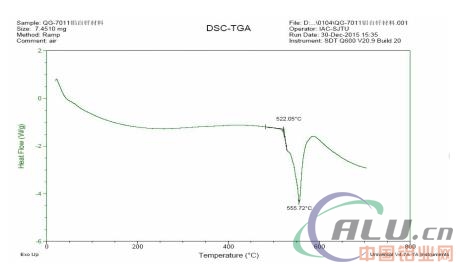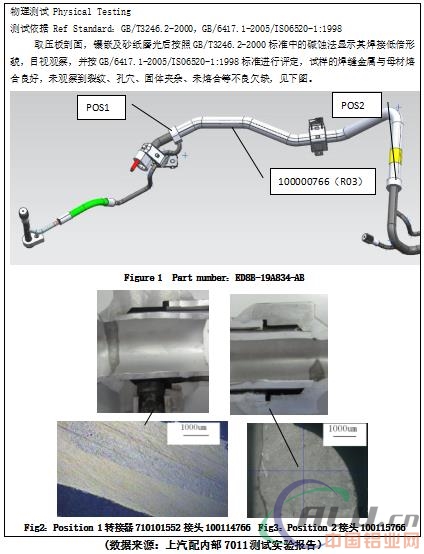
Privacy statement: Your privacy is very important to Us. Our company promises not to disclose your personal information to any external company with out your explicit permission.
[China Aluminum Network] article published in Lw2016 Proceedings - author Duan Zhaotao 1, Wang Guochun 2, He Zongchao 3, Zhuang Hongshou 4 (1, Suzhou Solder Valley Welding Materials Technology Co., Ltd.; 2, Shanghai Automotive Air Conditioning Parts Co., Ltd.; 3, Yi Fu Di Induction Equipment (Shanghai) Co., Ltd. 4. Beijing University of Aeronautics and Astronautics)
Abstract: 6 series aluminum alloys, especially 6061 aluminum alloys, have been widely used in industry because of their high strength. Due to the low solidus temperature of the alloy (580°C), the solder melting point of the conventional 4047, 4045, 4043 aluminum solders is all above 580°C. This can easily lead to overheating of the brazing base metal. . Therefore, brazing material scientists have been seeking the development of medium-temperature brazing materials for aluminum alloys. It is very urgent to develop aluminum brazing materials with a temperature lower than 580°C, preferably about 550°C, but it has been unsuccessful for nearly 50 years.
The 7011 series medium-temperature aluminum brazing material developed by the brazing valley technology, the brazing material solid line 522 °C, the liquidus line 556 °C, the brazing performance index is superior to the traditional 4047, 4043, 4045 aluminum brazing material, passes the auto vulcanization batch verification, All indicators meet customer requirements. This R&D result has the potential for industrialization.
a background
The problem of brazing of 6000 series deformed Al alloys has always been the focus of research at home and abroad. Due to the lack of low-melting-point solders with good overall performance, the softening of the base metal after brazing has not been properly solved.
At present, aluminum and aluminum alloys are brazed with 4 series Al-Si alloys. According to the silicon content, there are 4043, 4045, 4047 and other grades. The solder wets the aluminum alloy base material very well, has high welding strength and good corrosion resistance, and is a rare and excellent brazing material.
However, due to the theoretically high melting point of the solder, the melting point of the 4047 aluminum solder is as high as 577°C. Generally, the melting point of the brazing alloy is about 580°C, while the melting point of the aluminum alloy base metal is about 630°C. At 50°C, it is extremely easy to cause problems such as overburning of the aluminum alloy base metal and annealing of the base metal.
Brazing materials scientists at home and abroad have been researching and developing solders with lower melting points, better wettability, and better corrosion resistance than conventional 4047 aluminum solders. Although many papers and monographs have been discussed over the years, There was no one that could meet the industrialization requirements.
The direction of research in the past 50 years
According to published papers and monographs, in order to seek low-temperature aluminum brazing materials, more attention is focused on the following alloy materials:
Based on Al-Si alloys, appropriate amounts of Cu, Ni, Sn, and other elements were added to form Al alloy solders as the object of study.
By analyzing the effect of each additive element on the properties of the solder, the Al alloy brazing joint has good resistance to atmospheric environment corrosion while ensuring strength.
Si element and Cu element have a great influence on the liquidus temperature of the solder. The addition of both elements will significantly reduce the melting point of the solder. With the increase of the content of alloying elements, the alloy gradually changes from inconsistent melting to consistent melting, thereby reducing the melting temperature range.
The addition of Sn in the solder material will significantly reduce the corrosion resistance, while Ni will improve the corrosion resistance and mechanical properties of the solder. The mass fraction should not exceed 2%.
Specifically, brazing materials scientists at home and abroad mainly have the following ideas of alloy elements.
1 Al-Si-Cu-Zn solder
The liquidus temperature ranges from 500°C to 577°C. After the Cu element is added to the Al-Si solder, the flowability of the solder increases significantly. However, due to the high content of the CuAl intermetallic compound, it is brittle and can only be cast. It is difficult to process silk and foil.
Based on this alloy, it has been conducting research for several decades and has not been able to break through. Only the research of some papers has appeared and it has not been able to be industrialized.
2 Al-Si-Ag-Zn solder
The Al-Si-Ag phase in the solder, the ternary eutectic point at the Al angle, composition w(Al)=40%, w(Cu)=19.3%, w(Agl)=40.7%, brazing temperature 500 degrees.
This eutectic point has great advantages as brazing material. Brazing has good fluidity, and its color and aluminum base material are more consistent. However, the material is brittle and it is difficult to process wire and strip.
3 Al-Ge-Si solder
The liquidus temperature ranges from 425°C to 500°C. The basic alloy of this solder is an Al-Ge alloy, the eutectic mass fraction is w(Ge)=55%, and the temperature is 423°C.
The eutectic solder has good fluidity and excellent spreadability, but the material is extremely brittle, and the cast strip has almost no strength and it breaks down.
In summary, aluminum brazing materials based on Al-Si alloys have been reduced in melting point by a variety of alloys, and they have achieved theoretical breakthroughs. However, these studies have only stayed in the laboratory and although the temperature can be reduced, the materials Molding is very difficult. Al-Si-based solders have not been completely broken through in the past 50 years. There have been no suitable aluminum solders that can replace 4047.
Three 7011 series aluminum brazing alloy
The 7011 series aluminum solder is based on Al-Si solder. By adding elements such as Cu, Ge, and rare earth, and using the on-line annealing process in a pioneering manner, not only the melting point of the material is lowered, but also the brittleness of the solder is fundamental. On the solution.
It is easy to make welding wire, solder ring, solder tape, and solder foil.
At present, the batch test is conducted at Shanghai Auto Parts Co., Ltd. and it works well.
1 7011 Series Aluminum Alloy Solder DSC Curve

2 Weld tensile strength
Specific tensile test products and data are shown in the photo below; (by the previous product is welded with 7011 series welding ring, the second product is welded with 4047 series welding ring)
The aluminum tube base material used was a φ19.05 tube. The front root was used to break the base material with the 8100N, and the second was to break the base material with the 7100N.
Among them, 4047 series welding products are used, and the breakage site is around the weld seam.
In the products welded with the 7011 series welded ring, the broken part was the aluminum tube base material itself, and there was no effect around the weld.

3 welding time comparison test
Record and confirm welding time is automatically displayed and recorded by high frequency induction brazing automatic welding timer
The comparison data of the welding time and welding strength of the two are as follows:

From the table, we can easily find out the superiority of choosing 7011 welded ring welding, that is:
Welding time saved (47-40)/40 = 15%
Increased welding strength (8100-7100)/7100=14%
Based on the above test results, it is not difficult to find that whether the welding quality (tensile strength) or welding production efficiency (welding time), 7011 series welding ring automatic welding is superior to the 4047 series welding ring welding.
In addition, the appearance of the product after soldering with the 7011 series solder ring was visually verified after 20 consecutive pieces were manufactured by automatic soldering. The appearance of the solder was also superior to that of the 4047 solder ring. (Source: Shanghai Auto Parts Internal 7011 Test Report)
4 Weld joint defects


Review
7011 aluminum alloy solder not only solved the problem of high melting point of Al-Si alloy solder, but also took the lead in breaking the problem of brittleness in the field of material molding, and succeeded in allowing this solder to undergo mass production pilot tests. The development of solder has epoch-making significance.
references:
[1] Zhang Qiyun, Zhuang Hongshou. Brazing manual. Mechanical Industry Press.
[2] Zhuang Hongshou. Welding Journal. Aluminum alloy vacuum brazing, November 1980
[3] Huang Peng. Zhejiang University. Study on low-melting high-strength aluminum alloy brazing materials.
August 23, 2024
August 23, 2024
January 13, 2024
January 13, 2024
Enviar e-mail para este fornecedor
August 23, 2024
August 23, 2024
January 13, 2024
January 13, 2024

Privacy statement: Your privacy is very important to Us. Our company promises not to disclose your personal information to any external company with out your explicit permission.

Fill in more information so that we can get in touch with you faster
Privacy statement: Your privacy is very important to Us. Our company promises not to disclose your personal information to any external company with out your explicit permission.